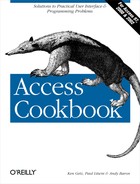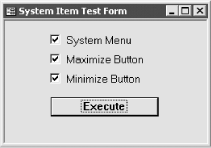The Windows API has a bad rap among many Access programmers who think it’s too hard to figure out, too hard to call, or just plain mysterious. We’re here to prove that none of these is the case—even if you’ve never seen the Windows API programmer’s reference, you can use the Windows API, given some help. In this chapter, we’ll present some interesting uses of the Windows API from within Access, with example forms and modules for each solution. In most cases, using these in your own applications entails little more than simply importing a module or two and then calling the functions. We’ve divided the solutions in this chapter into three broad categories, as follows:
- The Windows user interface
You’ll learn how to remove a form’s system menu, how to maximize and minimize buttons at runtime, and how to draw attention to a specific form by flashing its titlebar or icon. We’ll discuss language-independent classification of keypresses, so you can monitor exactly what keys have been pressed. We’ll also show how to restrict mouse movement to a specific area on the screen.
- The Windows shell
You’ll learn how to have asynchronous code run another program and pause until the other program is done before continuing. We’ll demonstrate a method for shutting down Windows under program control and show you all the options of the associated API functions. You’ll learn to find and run an application, given an associated data file, and how to determine if the application is already running. You’ll see how to retrieve a list of all open top-level windows (generally, one per application) and how to close a window from your VBA code.
- Files, drives, and hardware
You’ll learn how to set file date and time stamp information, which is useful if you’re moving files around from within applications or making backups based on dates. You’ll also learn how to retrieve information about your disk drives, hardware, and the current Windows environment as well as how to connect and disconnect from remote network devices programmatically or using standard dialogs.
Tip
Most of the solutions in this chapter instruct you to import one or more modules from the example databases. In each case, the module contains the Windows API user-defined types and function declarations you need for the example. If you’ve already imported a module with the specified name for a previous solution, you can skip it, since all modules with matching names contain the same code.
Access makes it easy to remove the control box (often called the system menu) and the minimize and maximize buttons when you design forms, but there doesn’t seem to be a way to do this at runtime. You have an application for which you’d like to be able to remove these buttons to control how users interact with the application. Is there a way to remove these items and then replace them later?
Removing or replacing these window controls requires changing the style bits for the particular window. Every window maintains a 32-bit value that describes its physical characteristics: for example, its border type and the existence of scrollbars, a system menu, and the minimize and maximize buttons. The values are stored as bit flags, in which the state of a single bit in the 32-bit value indicates the value of some characteristic of the window. In general, you can’t change the state of many of these flags without recreating the window; by setting or clearing the bits in the window’s style value, however, you can force the system menu and the minimize/maximize buttons to appear or disappear.
Load and run frmSystemItems from 11-01.MDB. This
form, shown in Figure 11-1, allows you to add or
remove the control menu, the minimize button, and the maximize button
from the current form. Select items on the form to make the
corresponding items visible, or deselect to remove them. Once
you’ve made your choices, click on the Execute button, and the
code will remove or replace the items you’ve chosen.
To include this functionality in your own applications, follow these steps:
Import the module basControl from
11-01.MDB.To remove or replace a form’s system items, call the acbFormSystemItems subroutine, passing to it the four parameters shown in Table 11-1.
Table 11-1. Parameters for acbFormSystemItems
Parameter
Type
Value
frmForm
Reference to the current form
fSystemMenuInteger
True = Show system menu; False = Hide
fMaxButtonInteger
True = Show maximize button; False = Hide
fMinButtonInteger
True = Show minimize button; False = Hide
For example, the following statement, called from a button’s Click event in a form’s module, will show the system menu but will hide the minimize and maximize buttons:
acbFormSystemItems Me, True, False, False
Though Access does provide the ControlBox, MaxButton, and MinButton properties for forms, they’re read-only once the form is in use; if you need to alter these properties at runtime, you’ll need to use acbFormSystemItems instead of changing the properties directly.
The bulk of the work in controlling these system items takes place in
the private HandleStyles function in the
basControl module. This function accepts a window handle (the hWnd
property of a form) and three
True/False values indicating
which options you want to see and which you want removed. Like every
window, the window you want to alter maintains a 32-bit value, its
style value. Within that long integer, each of the 32 positions
represents one of the possible styles for the window. If the bit is
1, the style is set on; if it’s 0, the style is set off.
HandleStyles builds up two long integers, each
containing a series of 32 bits. The first, lngStylesOn, contains all
0s, except for the bits representing the styles you want turned on,
which contain 1s. The other, lngStylesOff, contains all 1s, except
for the bits representing the styles you want turned off, which
contain 0s.
Using the AND operator
to combine the current window style with lngStylesOff sets each style
whose bit contains 0 in lngStylesOff to be 0. Using the
OR operator to combine the current window style
with lngStylesOn sets each style whose bit contains 1 in lngStylesOn
to be 1. For example, suppose the current window style value is this:
10001000 10001010 10101011 01101101
The value in lngStylesOff contains 1s in all positions except the ones you want turned off, which contain 0s. If the value of lngStylesOff is this:
11111111 11111111 11111111 11111011the result of using the AND operator with the
original style and lngStylesOff will be this:
10001000 10001010 10101011 01101001The value in lngStylesOn contains 0s in all positions except the ones you want turned on, which contain 1s. If the value of lngStylesOn is this:
00000000 00000000 00010000 10000000
the result of using the OR operator with
lngStylesOn and the result of ANDing the original
style with lngStylesOff will be this:
10001000 10001010 10111011 11101001
This final result will have three changed values: one bit that was 1 is now 0 due to the settings in lngStylesOff, and two bits that were are now 1 due to the settings in lnStylesOn.
To retrieve and replace the
window’s style information, the code uses the
GetWindowLong and
SetWindowLong API functions. Given a window
handle and a flag (GWL_STYLE) indicating which
32-bit value to retrieve or set, these functions allow you to get the
current value, do your work with it, and then set it back. This is
the line of code that does all the work:
HandleStyles = acb_apiSetWindowLong(hWnd, GWL_STYLE, _ (acb_apiGetWindowLong(hWnd, GWL_STYLE) And lngStylesOff) _ Or lngStylesOn)
It sets the window style to be the value GetWindowLong retrieved, combined with the two style flags the code previously built up based on your choices.
The entire HandleStyles procedure looks like this:
Private Function HandleStyles(ByVal hWnd As Long, fSystemMenu As Boolean, _
fMaxButton As Boolean, fMinButton As Boolean) As Long
Dim lngStylesOn As Long
Dim lngStylesOff As Long
On Error GoTo HandleStylesExit
' Set all bits off.
lngStylesOn = 0
' Set all bits on.
lngStylesOff = &HFFFFFFFF
' Turn ON bits to set attribute; turn OFF bits to turn attribute off.
If fSystemMenu Then
lngStylesOn = lngStylesOn Or WS_SYSMENU
Else
lngStylesOff = lngStylesOff And Not WS_SYSMENU
End If
If fMinButton Then
lngStylesOn = lngStylesOn Or WS_MINIMIZEBOX
Else
lngStylesOff = lngStylesOff And Not WS_MINIMIZEBOX
End If
If fMaxButton Then
lngStylesOn = lngStylesOn Or WS_MAXIMIZEBOX
Else
lngStylesOff = lngStylesOff And Not WS_MAXIMIZEBOX
End If
' Set the attributes as necessary.
HandleStyles = acb_apiSetWindowLong(hWnd, GWL_STYLE, _
(acb_apiGetWindowLong(hWnd, GWL_STYLE) And lngStylesOff) _
Or lngStylesOn)
' The 1 in the third parameter tells the window
' to repaint its entire border.
Call acb_SendMessage(hwnd, WM_NCPAINT, 1, 0)
HandleStylesExit:
Exit Function
End FunctionAfter the style bits are set, there’s still one issue left: you must coerce the window into repainting itself so the changes become visible. Simply changing the styles isn’t enough, because they don’t become visible until the next time the window repaints its border.
If you resize the form, Access repaints
the border, but there’s no reasonable programmatic way to do
this. To solve the problem, the procedure adds one more line. It
calls the SendMessage API, which sends a
specific message to any window (this time, it sends a message to the
form itself ). The message it sends, a constant named
WM_NCPAINT, tells the form to repaint its
non-client area (that is, its border):
' The 1 as the third parameter tells the window ' to repaint its entire border. Call acb_SendMessage(hwnd, WM_NCPAINT, 1, 0)

